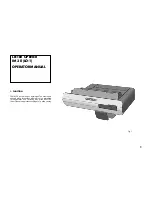
1-4
U
SER
M
ANUAL
750000992/16
Measurement Principles
MTS
e
2.
The power P2 at the output of the fiber section of two meters is measured and
serves as the reference.
The attenuation of the fiber tested is: P1 - P2.
This method is very accurate but is little used due to its destructive nature. It
cannot be used during maintenance or installation but only during the
manufacture of the fiber.
Insertion loss measurement method
1.
The power meter is first connected to the laser source via the reference fiber:
P1 is measured.
2.
The fiber to test is inserted between the reference fiber and the power meter:
P2 is measured.
3.
The difference between P2 and P1 gives the attenuation of the fiber under
test.
It is preferable to use the same type of connector at the extremities of the fiber
tested, in order to have the same connection conditions for the P1 and P2
measurements.
Although this method is less accurate than the previous method it is the most
common because it is non destructive.
Measurement accuracy
•
Very high accuracy is often necessary, It is therefore essential to first make a
calibration without the fiber under test to eliminate as much as possible
losses due to the connections. To do this use the OTS
“reference value”
function.
•
For measurements in a laboratory where the two extremities of the fiber are at
the same site the repeatability of the attenuation measurements is better than
0.1 dB. For measurements in the field, with the extremities of the fiber at
different sites, the variations between measurements is in the order of ± 0.2
dB (using a relative measurement).
Power measurement
The measurement of the power transmitted or received only requires a power
meter:
•
To measure the transmitted power, connect the power meter directly to the
output of the optical transmitter.
To measure the power at the input of an optical receiver, the power meter is
connected at the extremity of the fiber, where the optical receiver will be
connected.
WDM principle and analysis
The Wavelength Division Multiplex (WDM) technology is a very effective way to
increase the capacity of the fiber without having to install new links. Instead of
increasing the data rate, it enables the fiber to carry several wavelengths, each
wavelength transmitting signals. Channels are defined by the ITU-T
recommendations G-692.
Artisan Technology Group - Quality Instrumentation ... Guaranteed | (888) 88-SOURCE | www.artisantg.com
















































